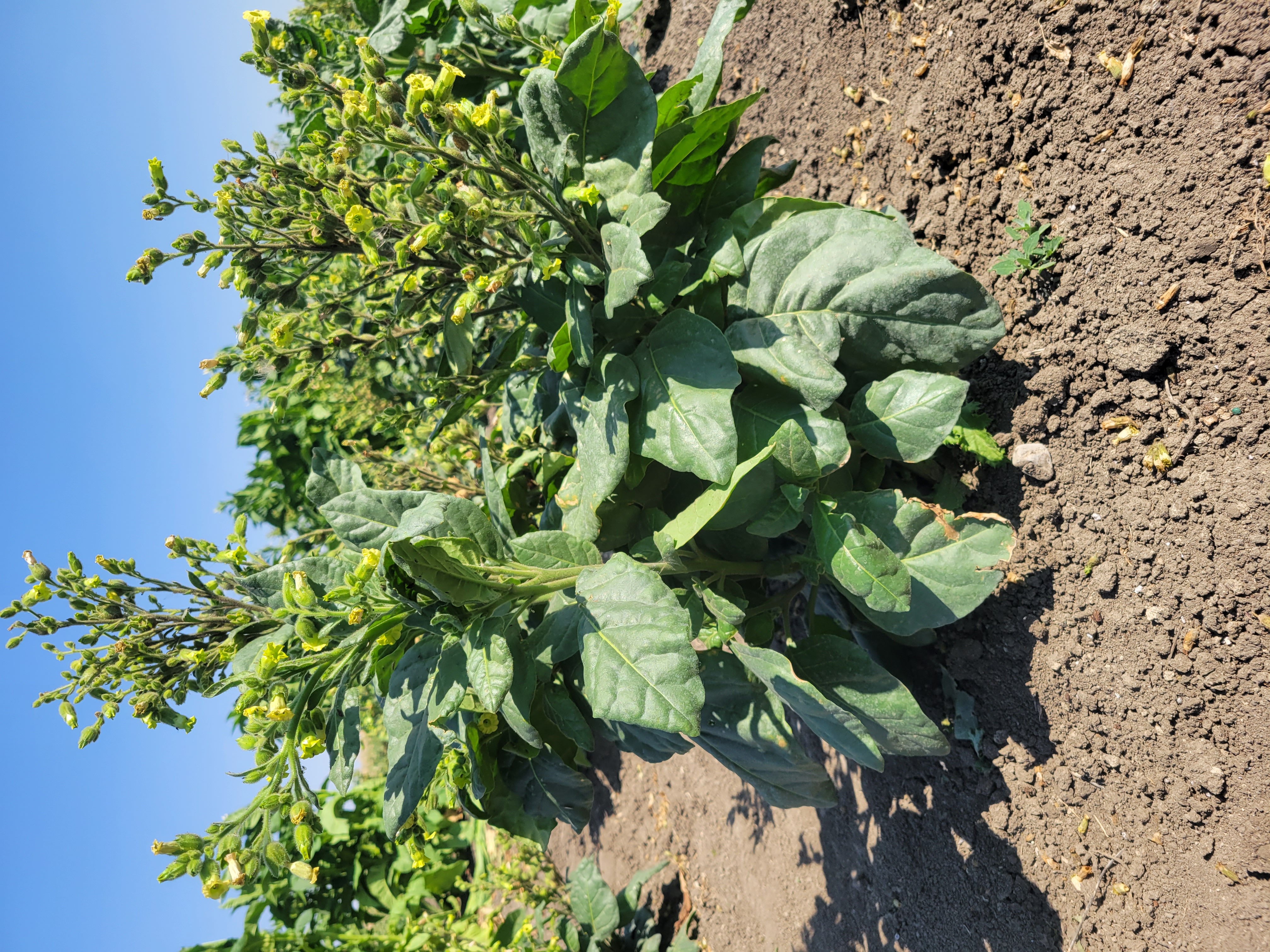"In my heart, the tobacco, once it’s lit, the smoke is going to take my message to the Creator for whatever my vows are."
—Elder Genevieve Bruised Head

Traditional tobacco plants harvested by the Keep Tobacco Sacred Collaboration with the Kainai First Nation. Credit: Treffrey Deerfoot
Traditional tobacco
Many Indigenous Peoples (First Nations and some Métis peoples) have a role for traditional tobacco as a sacred plant. Inuit peoples in Canada do not have traditional tobacco in their culture.
Traditional tobacco:
- may be burned to carry prayers to the spirit world
- is used in medicines and has healing properties
- may be given as an offering to Mother Earth
- can be given as a gift to an elder (This is a symbol of gratitude, respect, and the elder’s commitment to help you, often with prayers and spiritual guidance.)
Commercial tobacco
Commercial tobacco—such as cigarettes and
spit or smokeless tobacco—is different from traditional tobacco. Many harmful chemicals, like nicotine, have been added to commercial tobacco products as they are made. Some of these chemicals make the nicotine more addictive. Over time, using commercial tobacco products is dangerous for your health.
Health risks of commercial tobacco
Every year, more than 4,000 Albertans die from using commercial tobacco. Many more have tobacco-related illnesses.
At least half of all people who smoke will die because of their tobacco use, and over half of all First Nations people smoke. This means that more than 1 in 4 First Nations people could die early because of smoking.
Commercial tobacco and children
In First Nations communities, children often start using commercial tobacco—such as smoking and using spit or smokeless tobacco—much younger than in other communities. They typically start at age 12 to 16, but some start as young as age 7 or 8.
Recent studies show that vaping is also higher among Indigenous youth. While there’s still a lot to learn about the health risks of vaping, we do know that it can damage your lungs.
Commercial tobacco health risks to others
When you smoke or vape, the people around you also
breathe in the smoke or aerosol (vapour) created. These contain nicotine and dozens of harmful chemicals.
Being exposed to second-hand smoke (smoke you blow out or that comes from the burning end of a cigarette) is a health risk. It’s especially bad for babies because their lungs are still growing and developing.
Small children who live with people who smoke have a higher risk of diseases such as pneumonia, bronchitis, and middle-ear infections. They’re also more likely to have problems with coughs, colds, and ear and throat infections. First Nations have higher infant death rates, and being exposed to tobacco smoke is a major risk factor for crib death or SIDS (sudden infant death syndrome).
Third-hand smoke or aerosol stays on surfaces like clothes, walls, carpets, and furniture. There are more health risks to babies and young children from third-hand smoke because they breathe faster and crawl on floors. They also like to explore everything with their hands and put things into their mouths.
Serious health problems and commercial tobacco
Chronic obstructive pulmonary disease (COPD) is a serious lung disease linked to smoking. It’s twice as common among Indigenous people as the general Canadian population.
Lung cancer is the leading cause of cancer death among First Nations people, and the most likely cause of lung cancer is smoking.
COVID-19 is an illness that can cause people to have mild to severe lung problems. If you get COVID-19, smoking and vaping can put you at higher risk of getting very sick.
Traditional teachings and quitting commercial tobacco
Quitting or using less commercial tobacco is one of the most important things you can do for your health and your family’s health. The values below are based on the Seven Grandfather Teachings. This traditional Indigenous wisdom can help you make changes towards your healthy future:
-
Honesty: Be honest with yourself about the health risks of using commercial tobacco. When you smoke, vape, or use spit or smokeless tobacco, you put your health and the health of your family at risk.
-
Respect: Using commercial tobacco is not respecting the sacred place of tobacco in your culture. Giving prayer and thanks—as in traditional tobacco use—is honouring tobacco.
-
Humility: If you smoke tobacco, vape, or use spit or smokeless tobacco, you are putting your needs ahead of your family. If you smoke, your family is being exposed to second- and third-hand smoke. Your family and friends want you to live a long and healthy life.
-
Wisdom: If you would like to quit using commercial tobacco, think about the strengths you have to make a change. You don’t have to quit alone—reach out to others for help and support.
-
Truth: Telling others the truth about the differences between traditional tobacco and commercial tobacco can make a big difference in your community.
-
Love: Quitting smoking, vaping, or spit or smokeless tobacco is good for your health. Love yourself by making that change.
-
Bravery: Quitting smoking, vaping, or spit or smokeless tobacco can be hard. But you can do it.
For more information and support to quit using commercial tobacco, go to:
For more information about the role of traditional tobacco with many First Nations within the 3 treaty areas inside Alberta, visit
Keep Tobacco Sacred.
